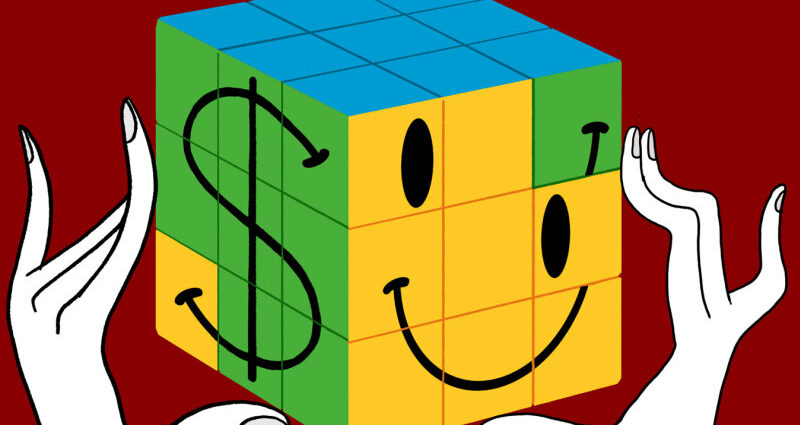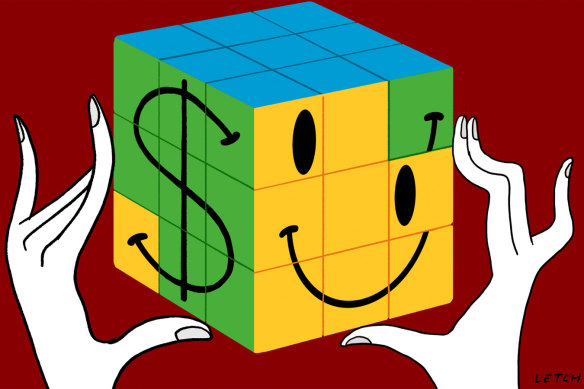Save articles for later
Add articles to your saved list and come back to them any time.
In this rushing world, it’s easy for the new, the exciting, the entertaining or the worrying to crowd out the merely important. But that’s one reason mastheads have columnists. To say, hey, don’t overlook this, it’s important.
If, like all sensible people, you think there’s more to life than gross domestic product – more than “the economy”, narrowly defined – you need to take more notice of Treasurer Jim Chalmers’ long-promised Measuring What Matters wellbeing framework, released on Friday.
Illustration by Simon Letch.Credit:
Taken as just another news story, it was a remarkably unremarkable document. It gathered 50 statistical indicators of Australians’ wellbeing, only a few of which were the standard economic indicators.
Of these, 20 show an improvement since the early 2000s, 12 have deteriorated, while the rest have shown little change or mixed outcomes. Our headline shouted the astonishing news: “We’re living longer, but cuddly animals are on the decline.”
Meanwhile, the government’s unceasing critics had much sneering fun pointing out how outdated some figures were. Did you see they say home owners are finding it easier to repay their mortgages?
Hopeless. It’s obviously just Labor’s “pitch to progressives living in Green and teal colonies”.
Actually, it’s a genuine effort to acknowledge and pay more attention to all the aspects of our lives that matter in addition to how many of us have jobs, how much we earn and what we’re spending it on.
The people who know a lot and care a lot about our wellbeing, in all its dimensions – such as Warwick Smith, director of the Centre for Policy Development’s Wellbeing Initiative – were much less critical. They said it was a good start, and could be improved and built upon, with the ultimate objective of having our greater consciousness of these other priority areas doing more to influence what the government was spending its time trying to improve.
Few economists would disagree with the frequent claim that GDP isn’t a good measure of wellbeing or progress. Indeed, the first person to say it was the bloke who invented GDP in the 1930s, Simon Kuznets.
It’s just that, economists being economists, they’ve continued to focus on GDP – economic growth – and left the better measures of wellbeing to others. Politicians have continued to focus on economic growth because that’s what the rich and powerful care most about. They’re hoping it will make them richer and more powerful.
It’s precisely because our leaders have been so focused on GDP as a measure of economic growth that our economic statistics are comprehensive and up to date, but our measurements of other things aren’t.
So, getting fair dinkum about “measuring what matters” involves giving the Australian Bureau of Statistics more money to measure the other things that matter more fully and more frequently.
Having been a bean counter in both my careers, I know the boring, pettifogging importance of measurement. As they say, what gets measured gets managed. You want to get your map sorted before you take off into the jungle.
But what are the other, non-standard things that matter most to our wellbeing? This is what we got on Friday: the government’s decision about the key components of wellbeing. This is the wellbeing “framework”.
It nominates five dimensions of wellbeing. First, health. “A society in which people feel well and are in good physical and mental health, can access services when they need, and have the information they require to take action to improve their health,” the framework says.
Second, security. “A society where people live peacefully, feel safe, have financial security and access to housing.”
Third, sustainability. “A society that sustainably uses natural and financial resources, protects and repairs the environment and builds resilience to combat challenges.”
Fourth, cohesion. “A society that supports connections with family, friends and the community, values diversity, promotes belonging and culture.”
Treasurer Jim Chalmers’ wellbeing framework is remarkably unremarkable.Credit: Paul Harris
And finally, prosperity. “A society that has a dynamic, strong economy, invests in people’s skills and education, and provides broad opportunities for employment and well-paid, secure jobs.”
Each of these five “themes” (dimensions is a better word) are “underpinned” by the need for “inclusion, equity and fairness” (but if there’s a difference between equity and fairness, I don’t know it).
I think that covers the bases. Sounds a nice place to live. It puts the economy into a broader, more balanced context. It’s vitally important – it’s our bread and butter, after all – but so are many other things.
If we nail it on prosperity but go backward on the others, why would that be good? The rich could survey the ruins around them and say, I won!
And there’s a lot of interdependence. Good luck with your economy once you’ve irreparably damaged the natural environment on which it depends.
On many of these dimensions, what we need to know is not so much how well we’re doing on average, but who’s missing out and needs help. Not who’s included, but who’s excluded. (Something a Voice would make it harder to forget.)
But measurement is just a means to an end. Until what we know affects what our governments do, it’s just box-ticking.
Ross Gittins is the economics editor.
Ross Gittins unpacks the economy in an exclusive subscriber-only newsletter every Tuesday evening. Sign up to receive it here.
Most Viewed in Business
From our partners
Source: Read Full Article



